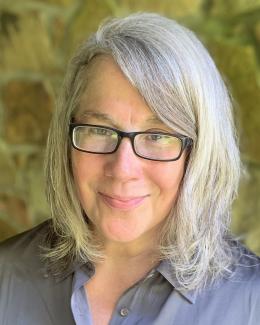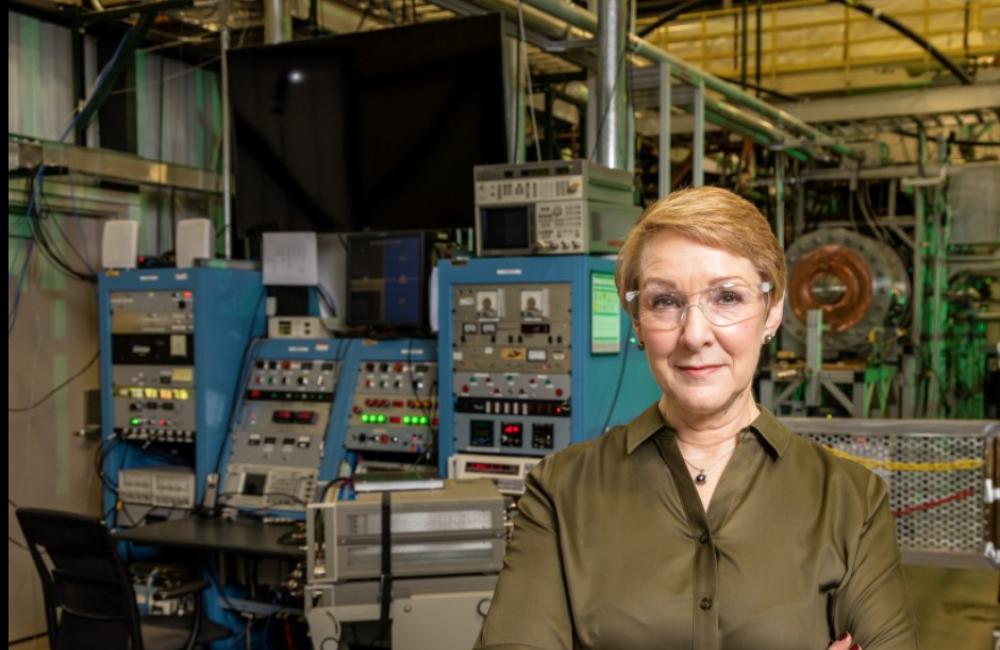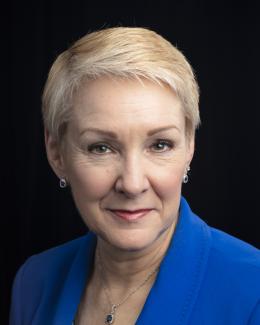Associate Laboratory Director Kathy McCarthy heads the ORNL directorate that manages proto-MPEX, a linear plasma device that informs the development of the MPEX tool for study of fusion materials. Credit: Carlos Jones/ORNL, U.S. Dept. of Energy
From the helm of a one-of-a-kind organization that brings nuclear fusion and fission expertise together to pave the way to expanding carbon-free energy, Kathy McCarthy can trace the first step of her engineering career back to a childhood fishing trip.
“When I was around 9 or 10 years old, I was fishing with my father, using grasshoppers we had caught as bait. I became frustrated when a bunch of grasshoppers jumped out of the container each time I opened the lid to put one on my hook,” she said. “My dad said, ‘Why don’t we design a device we could build to get out a grasshopper without letting the others escape?’ The realization that I could design and build something to solve a problem planted a seed that later helped lead me into engineering.”
A nuclear engineer by training, McCarthy became associate laboratory director of the newly created Fusion and Fission Energy and Science Directorate in March 2020 at the Department of Energy’s Oak Ridge National Laboratory, where she also serves as director of the US ITER Project. The directorate combines ORNL’s expertise in nuclear energy and fuel cycle research, fusion science and technology, and management of US ITER, which delivers U.S. contributions to the international ITER fusion project, in one organization.
“By putting these three elements together, we are creating a synergy that doesn’t exist anywhere else in the world,” McCarthy said. “This synergy empowers our researchers to look ahead at how to solve challenges for the world’s energy supply.
“We have fusion device design and construction experience. We have nuclear reactor and fuel cycle experience. We have government regulations experience in both fission and fusion. We have nuclear and plasma physics science expertise. We are combining all of this to design the future of energy while also supporting the delivery of energy today,” she said.
Before joining ORNL, McCarthy directed science and technology at Canadian Nuclear Laboratories, where she oversaw a staff of 650, grew the labs’ commercial work and helped pioneer R&D of small modular reactors. She previously held a variety of leadership and engineering roles in nuclear science and technology at Idaho National Laboratory, where she led both fusion and fission R&D. Early in her career, she conducted fusion research in what was then West Germany, and the Soviet Union, in both Russia and Latvia.
From the start of her career, her research and leadership skills have been noticed. When she completed her doctorate in nuclear engineering from the University of California, Los Angeles, she was invited to be a guest scientist at the Kernforschungszentrum in Karlsruhe, West Germany, which was followed by the U.S. Department of Energy selecting her as a participant in its US/USSR Young Scientist Program.
More recently, in 2019, she was inducted as a member of the National Academy of Engineering for her leadership in research and data analysis in support of licensing extensions for light water nuclear reactors, and she has received two American Nuclear Society Presidential Citations.
Thinking back to what led her to choose a career in nuclear engineering, she credits her parents and her high school physics teacher.
“My dad was a chemical engineer at a national lab, so I grew up in a family and a community that valued science and math. I still have my first Lego set that my parents gave to me when I was around 7 or 8 years old.”
During her senior year of high school as she was contemplating what major to pursue in college, the Three Mile Island nuclear reactor accident occurred.
“My high school physics teacher discussed the accident with us, talking with us about the technical challenges and the benefits of nuclear energy,” she said. “I thought, ‘Wow, this is important from a clean energy perspective. This is important for the world. Maybe I should go into nuclear engineering and help solve some of these challenges.’ “
That ideal that first bloomed in her mind during a high school physics class continues to push her forward today.
“When ORNL Director Thomas Zacharia invited me to lead this new directorate, I knew it was an opportunity I could not pass up,” she said. “Here at ORNL, in this organization, we have something unique, something that doesn’t exist anywhere else in the world. And through it, we have the opportunity to advance the world toward expanded carbon-free energy supplies.” — Amy Reed
ORNL is managed by UT-Battelle for the Department of Energy’s Office of Science, the single largest supporter of basic research in the physical sciences in the United States. DOE’s Office of Science is working to address some of the most pressing challenges of our time. For more information, please visit energy.gov/science.




